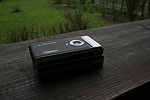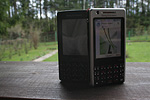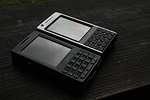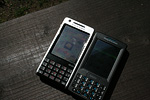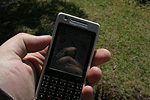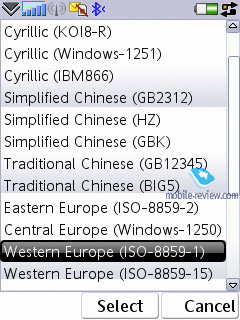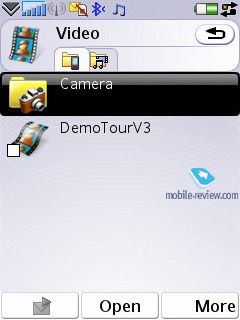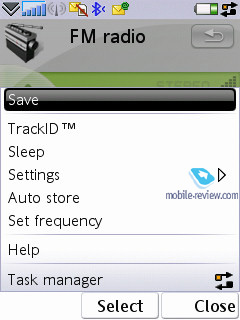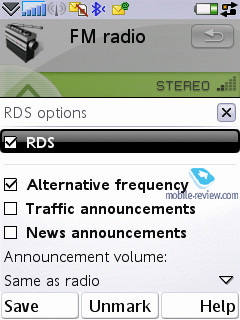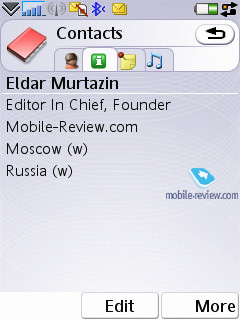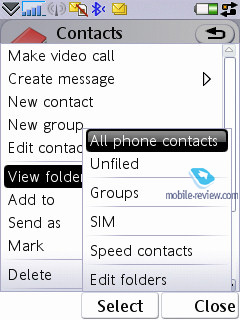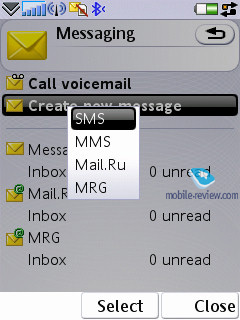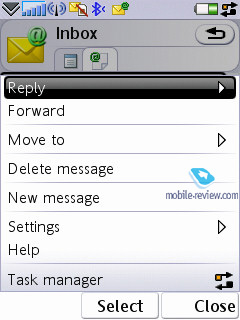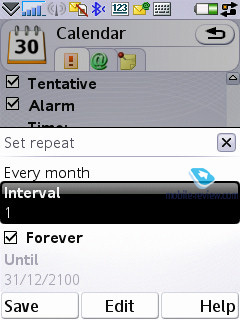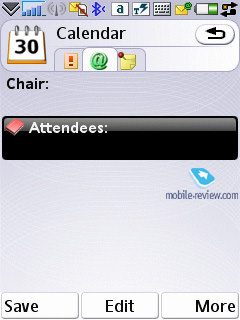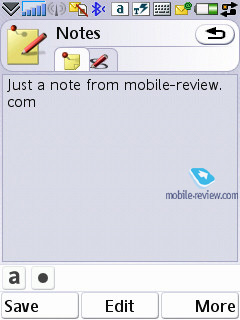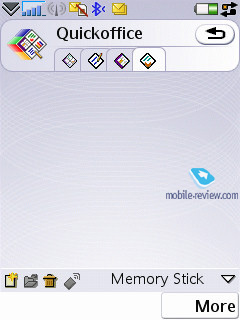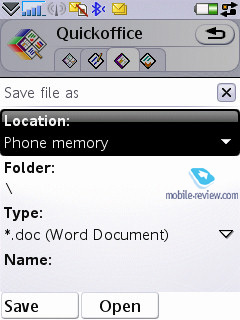|
|
Review of GSM/UMTS-smartphone Sony Ericsson P1i
Live photos of Sony Ericsson P1i
Table of contents:
- Design
- Controls
- Display
- Keyboard
- Battery
- USB, Bluetooth, Infrared, WiFi
- USB
- IrDA
- Bluetooth
- WiFi
- VoIP
- Memory card
- Performance
- Hardware specifications
- Comparison with Sony Ericsson P990i
- P1i versus Sony Ericsson M600i
- Localization quality
- Interface
- Text input and display
- Music department
- FM-radio
- TrackID
- Games
- Camera
- Contacts
- Messaging
- Email client
- Organizer
- To-Do list
- Alarm Clocks
- Flight Mode
- Connections manager
- Office applications
- Some other features, themes, web-browser
- Calculator
- Voice
- Picture gallery
- Picture editor
- MusicD
- Unit converter
- Stopwatch
- Countdown
- Themes
- Storage Wizard
- RSS Feeds
- Competition (Nokia E61i)
- Impressions
Sales package:
- Handset
- 1160 mAh Li-Pol battery
- Desktop cradle CDS-65
- Travel charger
- M2 512 Mb memory card
- USB-cable
- Wired stereo-headset HPM-62
- Spare stylus
- Carrying case
- User Guide
- CD with software
Historically, the roots of this product go back to the Sony Ericsson M600i – they share the same philosophy, form-factor and other aspects. The parent model was one of the first UIQ 3.0-running offerings, however limited RAM volume, novelty of the operating system, omitted camera and WiFi pushed this product in a particular niche. The maker had meant to release the flagship, specifically the Sony Ericsson P990i, long before the M600, but it didn’t happen. And for the first time for Sony Ericsson, the number of errors people kept coming across the first months into use, provoked an avalanche of negative reviews and step by step many were leaving these smartphones out. It is significant that the Sony Ericsson M600i’s price on some markets has gone all the way down to the floor – in Moscow, for example, it makes up around 340 these days. The history of the M-range has turned out to be not quite promising. Interestingly, for the P990i the number of errors was far greater, yet inbuilt camera, WiFi, bundled radio and the charisma of the P-series have saved the day, defending both its image and current sales. Within its segment, the product has proven to be quite a success; even today it generates tidy sale rates.

For Sony Ericsson one of the prioritized fields is development of UIQ-smartphones, yet limited funds and R&D-resources don’t do the company justice, not allowing it to release a batch of offerings at a time. The year 2006 saw three smartphones of this kind – the P990i, M600i, W950i (with local editions of these devices ignored). In 2007 the company was setting off to launch at least around 7 handsets, out of which three will be the base editions and the other four will act as variations (music edition, with/without camera, enabled/disabled WiFi). But these intentions will never become something bigger and more real; over there they have totally revised the UIQ-related strategy.
In 2006, Sony Ericsson was negotiating Symbian on the possibility of buying out its subsidiary, UIQ Technology, which had previously been with the big Ericsson. The reason was stale – Nokia became Symbian’s largest stakeholder in 2006, being Sony Ericsson’s major rival on the world market. Development of UIQ under the same roof with Nokia’s solution was risky, to a certain extent, for Nokia as well – they wouldn’t like to have both branches going head to head. Basically, this is what’s happening with the today’s products on S60 and UIQ – it is a kind of tug-of-war, when one or another function gets superior on either platform, then the other platform catches up and so on. Investing own brains to the full in a situation like this was next to impossible, so development of the UIQ-products proceeded with substantial barriers – the main focus was put on A100 platform for feature phones. For instance, in the middle of 2007, SIP is getting to be the standard component for Java in JP-8 for A100 platform, the Sony Ericsson Z750 is the first example of that. At the same time, this technology may materialize in UIQ only starting from version 3.2 (in the same scope an implementation fashion).

Having reached a firm agreement on purchase of UIQ Technology in November, 2006, Sony Ericsson got into revising of the prospects – with great ambitions, the company intends to morph UIQ into Nokia’s S60 counterparts, invest into UIQ development and establishment of various device classes. But at the same time this means that the period of soul-searching, dynamic development and integration of novel features will take a while, and it would make sense to expect crammed schedule only for releases of devices sporting full-fledged update to the next version of UIQ in the end of 2008 (Symbian 9.5 – touchscreen-enabled/disabled devices for 250 Euro plus). Since the beginning of 2007 they have totally revised, it took them about 5 months, though.
For the first six months of 2007, the maker had two ready-for-release devices on hands – the Sony Ericsson M610i, and also the Sony Ericsson P700i. The latter went “gold” as the P1 – the review of this smartphone is what you are currently reading. Model Sony Ericsson M610i shares the design cues with the P700i/P1, yet stands out in view of the missing camera. The handset got cancelled due to a number of reasons, including low popularity of the predecessor, orientation towards mobile powerhouses until the end of 2008 again, meaning that a camera becomes a welcome addition. Technology-wise the offerings form a perfect pair of twins, that is why even at a 70-100 Euro gap, the junior model wouldn’t have become a record breaker in terms of sales. At the very last moment we found out that this device actually will be shipped in small lots to a number of countries, due to its being ready for release and production technology identical tp the P1i.

From the very beginning, the P700i index indicated that this product is by no means a top-of-the-line solution and a replacement for the Sony Ericsson P990i. It finds its place somewhere between the Sony Ericsson M600i and Sony Ericsson P990i, at that, luring away prospects from both. For the buyers of the former it offers a deal-breaking rich feature pack, for those caring for the latter, portability and the same functionality, all available in a different design. Had the maker originally decided to produce this trio simultaneously for a while, we would have witnessed sales increase for the P700i.
Some time prior to the official announcement, they decided on a new name and respective positioning. The press-release features it as the fifth generation of the P-series smartphones with blowing functionality. Visually, though, it is nowhere near any of the predecessors – they looked differently. We shall remind you, that the P-series has been represented on the market by – Sony Ericsson P800i, Sony Ericsson P900i, Sony Ericsson P910i, Sony Ericsson P990i.
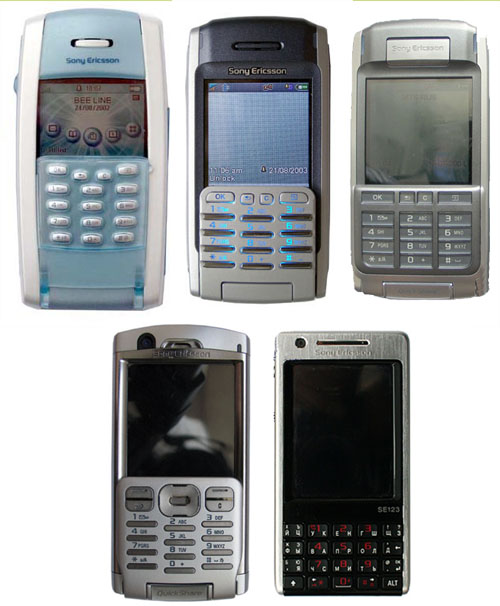
Such bold step and positioning of the P1 as a replacement for the Sony Ericsson P990i unveils a handful of curious facts:
- The P1 index shows that the device opens up the product line of the P-series, though the question is, whether simplified editions of this phone will ever see release. Not likely, but if that’s the case, the vendor can always turn to another index, for example M.;
- The real successor to the P990i is pending, with its release date rescheduled for the turn of 2007, beginning of 2007. The handset will carry the same RAM volume as the P1, yet will come with improved CPU speed and maintain flip. The design is reminiscent of the first four models of the series;
- UIQ 3.1 is considered by the manufacturer as a intermediate version of UIQ, already existing devices won’t get upgraded to this version;
- The lifecycle of the P1 will make up at least 12 months;
But that’s all theory and history; now let us take a plunge into the depths of the P1.
Design
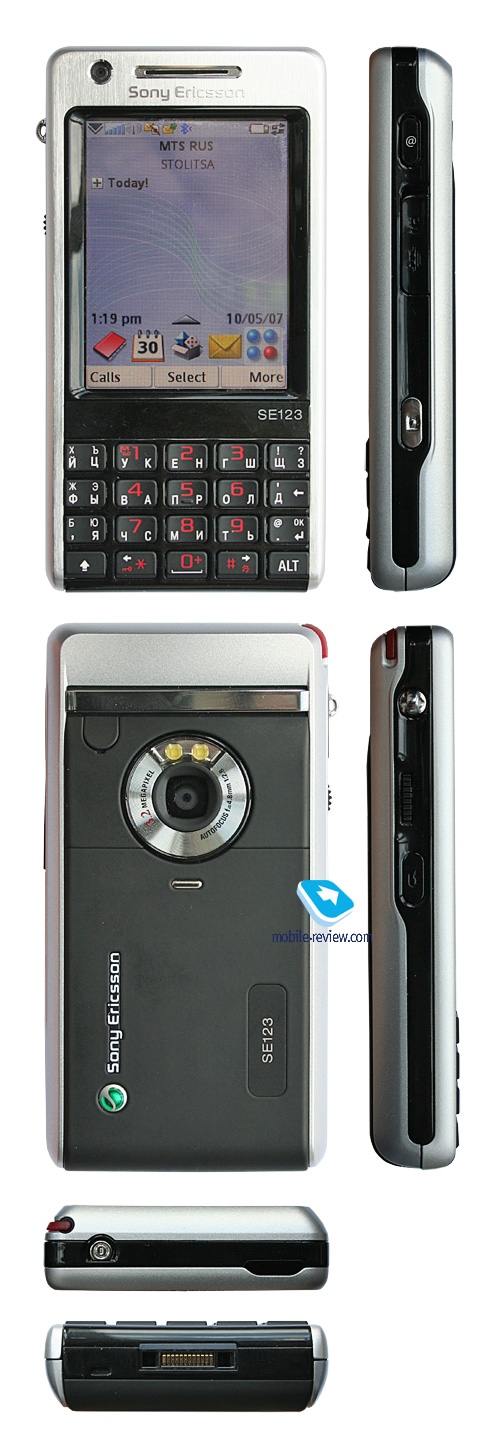
Design-wise this model is a direct successor to the Sony Ericsson M600, these two do look very alike.

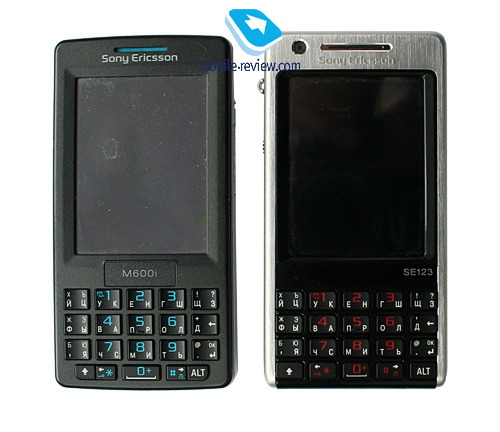
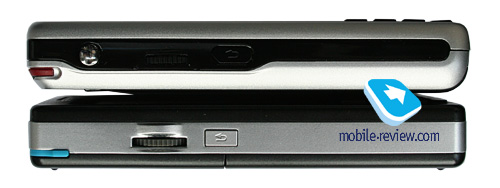



But this is what concerns a glimpse, in fact the differences are many – unlike the M600, the P1 features the front plate clad in brushed metal, giving it a more distinct feel. The first parallels coming across your mind would be the Nokia E61 and Nokia E61i. Both had metal-finished battery covers, but it is only the updated edition where the metal does make a statement, rather than ends up being disguise to look like plastic. This year’s trend implies maximum highlight for all metal details of the casing, consumers have finally tasted such solutions and automatically link this material to its price or prowess (reliability, price, quality).
The Sony Ericsson P1i measures up at 106x55x17 mm (for M600 – 107x57x15 mm), which makes it obvious that it has marginally gained only in thickness, while the P1 shaves some millimeters from its forefather in the rest. Though it weights 125 grams, which is heavier that the M600’s 112 grams. In the sense of dimensions, the model is pretty much in line with feature phones, which makes it stand out against the backdrop of many other today’s smartphones. The handset comes in a sole color scheme – Silver Black.

The perk of Sony Ericsson’s products is color-keyed design elements, which underscores the flavor of every model. And smartphones is where this trait comes at its best. Remember the Sony Ericsson M600i’s keyboard – all captions are made in blue, the similarly-painted inset is mounted on the rear, where the loud speaker and the color-keyed stylus rest. For the Sony Ericsson W950i the color is orange, for it comes from the Walkman family. The Sony Ericsson P1i comes with red accents, placed on the keyboard and the stylus.

The handset wins from having expertly picked and combined materials – metal on the front fascia goes shoulder to shoulder with the plastic on the sides, this is another characteristic feature of the flagship solutions. At the same time, the underside of the P1 features nothing but soft-touch plastic, which feels much like the Sony Ericsson K790/K800. Thanks to its matte plastic, the P1i doesn’t feel insecure on inclined surfaces and sits on one place firmly. For example, thrown in car, the Sony Ericsson P1i seems to do much better than the M600i.
Under the chrome-plated inset on the rear is the loud speaker, mounted here due to the camera module, which now occupies its usual place.

Back to the table of contents >>>
Controls

While the device fits either hand, it is still tailored to be managed by right-handers. In this case it lies in your left hand and your thumb automatically finds the JogDial. This control element is identical to what we experienced with the Sony Ericsson P990i, allowing you to scroll or press it, but nothing more, like it was with the Sony Ericsson P910i, Sony Ericsson P900i, Although, by and large, these additional capabilities are not essential in this handset – the software makes good use of the available controls, which adds points to its usability. A tad beneath the JogDial is the Back button for going one level up in the menu or jumping to the standby screen.


An improvement over the Sony Ericsson M600i is forgoing of the JogDial’s slot (plastic ridge), the wheel itself feels stiffer, yet it is by far a more pleasant experience.
The left-hand flank houses the strap holder, which is a better location than the bottom edge on the previous device.

The right spine holds the dedicated camera button, topped by the browser shortcut key, which can be reassigned to launch other applications the handset comes pre-installed with.

The lower end plays host to the service indicator, which is not the best place for it, though, except for when you have the P1 lying on the table right before you. Yet an indicator like that found in the Sony Ericsson P990i is an obvious positive.

The SIM-card bed beneath the battery is conventional, unlike the M600i with its runners.


Back to the table of contents >>>
Display
Technically, the M600i and the P1i’s screens are identical, or that’s what the first impression suggests. It is a QVGA resolution (240x320 pixels) display measuring 2,6 inches from corner to corner (39x53 mm), 262 K colors. Comparison of one and the same image displayed on these handsets tells us that the brightness and contrast parameters are even.


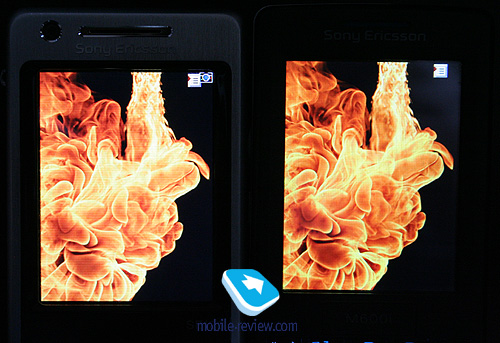

Nonetheless, the maker claims improved sun resistance for the P1i’s display – we checked this, and to our great surprise found out that there was much truth in it, the picture proved to be more legible. Where the M600i’s display gets washed out to the last pixel, the P1i keeps it readable. Even though this difference is not substantial, it becomes apparent on long usage sessions.
The display is prone to smudge, picking up grease from fingers and ears with ease. A partial way-out is a protective film, which will also come in handy if you are going to use the handset for more than a year (prevents the screen surface from getting worn-out).
The screen can hold up to 14 text and 3 service lines. Information is fairly legible; fonts can be adjusted to your liking. The P1i does well in the sun, when indoors it outputs crisp and color-saturated picture. Yet setting it against displays with smaller diagonal, you will surely notice that its picture quality is inferior – even the Samsung D900i puts up a richer picture (or the Motorola Z8).
Back to the table of contents >>>
Keyboard
Unlike the Sony Ericsson M600i, this phone sports somewhat differently size keys; also the bend in the middle has become softer, which has allowed the ergonomics of the solution to improve. The P1i even enables one-handed input, which was one of my favorites, the only thing to keep in mind when doing this is the second row of symbols which is impossible to use without another hand involved. All buttons are pretty much the same size-wise here, whereas the M600 features tiny functional keys in the bottom row. Those who haven’t ever dealt with the previous model – read below to find out how this keyboard works.

Being petty-sized, the keys are spaced out, which nearly excludes the possibility of hitting adjacent keys. The reason why you see one symbol on either side is the rocker-style buttons – when tapping on the key you should have a clear understanding whether it is left or right that you want to press. On the plus side, this allows bringing about bigger keys, rather than employing one-symbol-per-skinny-key setup, but they take some getting used to, get yourself ready for confusing hits in the beginning The QWERTY-keyboard embedded in this device is substantially different from the solutions present in the market these days, but those who hasn’t had any previous experience of punching more conventional thumbboard will be right at home after mastering the input process.

The numeric keys are put in the centre and marked in red – in most modes allowing only for input of numbers they get activated automatically, though the text fields will require manual shifts done by pressing Alt. The top row of extra symbols works pretty much in the same way. In the end, the text input turns out to be quite speedy – even more so than on a normal keypad, though keep in mind that writing essays several pages long with this keyboard is quite a challenge. Furthermore, with a touch-screen onboard, the handset barely needs a QWERTY-keyboard, for the most part it is engaged only for keying to certain services provided by carries, that’s it. Apart from the keypad, you can opt for the on-screen keyboard and handwriting recognition. The model will come in three language editions, each with own unique key captions (English, Cyrillic, Azeri). Russia will get two editions – English and Cyrillic – as with no leftover space they couldn’t implement both layouts. At that via the software, the handset’s keys can be bound to English letters, even when they have Cyrillic alphabet etched on them, however this doesn’t make much sense.
The keys are lit in dim white, which is well-visible in various environments, including direct sunlight.
Back to the table of contents >>>
Battery
In one of the press-releases that were never meant to reach the masses, features some lines on the Sony Ericsson P1i having BST-40 battery (Li-Pol, 1020 mAh). Someone who got his hands on this information, upon the product announcement started assuring everyone that this very battery will be incorporated into the phone, some even quoted its capacity at 1060 mAh. This battery is not ready as yet, and more likely, we won’t see it in this device. The same held true for the BST-34, which should have made the debut in the Sony Ericsson P990i, but wasn’t set on the production line. This way, the smartphone gained a hold-down inset on the battery compartment cover, for there was more space inside than the battery occupied. Nevertheless, the P1i’s default battery firmly sits in its socket and delivers no issues of this kind.


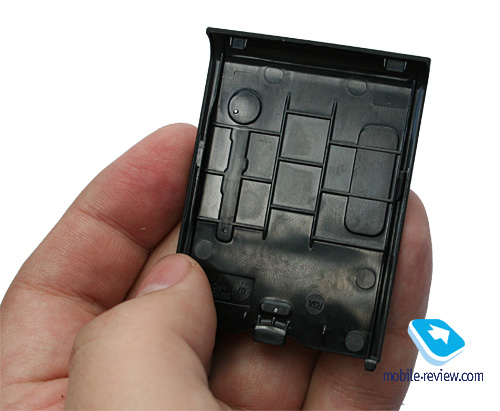
All samples come included with BST-33 battery (Li-Pol, 950 mAh) which doesn’t differ from other smartphones by the company. The maker quotes the battery life at 5-10 hours and up to 440 hours for talk and standby times respectively. In conditions of Moscow networks, the handset lasted for about 2 days, at one hour of calls, up to 6 hours of music playback, 2 hours of radio, rare file transfers over Bluetooth and up to 20 minutes of mail checks, web browsing. It takes the P1i about 2 hours to charge up from empty to full. It doesn’t differ a bit from the Sony Ericsson M600i in the sense of battery life.
In the most intensive mode of usage, the charge on the batter lives for 1 day – during this time span not only can you listen to music without taking a break, but also check mail and browse Internet pages on regular basis. Taking into consideration that the majority of users don’t employ capabilities of the device to this extent, we can talk about average battery time of around two days, but it depends on the given case. Those, who don’t aim at listening to music and using other functions too often, the device will offer 2-3 days of battery time. From my point of view, three days at this pace aren’t too hard to achieve, but in this case, purchase of this device loses any meaning.
The handset comes boxed with a desktop charger (CDS-65), which doubles as the cable-sync device.

Back to the table of contents >>>
USB, Bluetooth, ÈÊ-ïîðò, WiFi
USB. Files are transferred onto the P1i via USB-connection with 2.0 Full Speed version (12 Mbps) supported. Upon connection to a PC the smartphone is displayed as a USB Mass Storage, which allows the user to see all sections, saving for system folders. Another way to pair up the P1i with your PC via USB is Modem mode, when the smartphone starts acting as a wireless modem.
ÈÊ-ïîðò. The device features full-fledged implementation of data transfers via IrDA to and from other devices. It can serve as a connecting link when the smartphone is operating as a GPRS-modem. Data speeds from 9.6 kbps to 115.2 kbps are fully supported in the handset, as well as the following protocols: IrOBEX 1.2, IRCOMM 1.0, IrTRANP 1.0.
Bluetooth. The P1i comes equipped with EDR-enabled Bluetooth 2.0 and allows for up to 16 devices on the list. The following profiles are supported:
- Dial-Up Networking Profile
- Generic Access Profile
- Generic Object Exchange Profile
- Object Push Profile
- Serial Port Profile
- Handsfree Profile
- Headset Profile
- Synchronization Profile
- Basic Image Profile
- File Transfer Profile
- HID (host) Profile
- Stereo Advanced Audio Distribution Profile
- Advanced Audio/Video Remote Conference Profile
The Bluetooth implementation is, as always though, nothing to complain about, we encountered no issues with handling this type of connections.
WiFi. The handset shows off support for 802.11b (11 mbps), enabling you to connect to two access points and has nothing against pairing up with hotspots. Going online through WiFi allows all preinstalled applications that have something to do with Internet connections to start up and operate properly. The inbuilt WiFi makes checking mail, surfing web a very gratifying experience. The smartphone can use network connections established on other devices (while being connected to them via cable, infrared or Bluetooth). WiFi didn’t deliver any hardships; listing extra options, we can’t overlook the possibility of saving settings for certain networks.
The following authentication profiles are supported:
- WEP
- Shared WEP
- Dynamic WEP
- WPA Personal è WPA2 Personal
- WPA Enterprise è WPA2 Enterprise
VoIP. Sony Ericsson hasn’t come up with a standard VoIP solution, yet has polished and prepared all libraries, which makes it possible for third-party companies to develop custom applications. They can utilize WiFi connection for VoIP calls, support on-the-go switching to another network connection, if WiFi signal suddenly breaks down, also there are codecs available for improved sound quality and so on. An example of such client is the software by OptiMobile
Back to the table of contents >>>
Memory card
The retail package contains an M2 512 Mb card, though the device can handle cards up to 4 Gb. The hot-swappable memory expansion slot is mounted on the right-hand side and covered by a plastic flap.
Performance
The model runs on the same hardware chassis as the previous Sony Ericsson’s offerings, meaning that it is powered by ARM9 processor, whose frequency tops out at 220 MHz (though in real-life it runs at 180 MHz). In fact the CPU is the system’s greatest headache, that doesn’t allow going for even better performance. This doesn’t necessarily mean that the P1i is sluggish – by no means. The handset is on par with S60 smartphones, entering or exiting items takes about 1-2 seconds. But when looking at the models Nokia is preparing for its September announcement, these will put up some somewhat speedier interfaces. Facing off the menu browsing speed of the Sony Ericsson M600i and the P1i, it is easy to notice that no newsworthy changes have been made, however the increased memory bank has left a positive impact on the stability of the device, rather than on its overall speed.




Back to the table of contents >>>
Hardware specifications
- Codename: Elena
- Operating system: Symbian 9.1, UIQ 3.0
- CPU: ARM9, 220 MHz (real frequency – 180 MHz)
- RAM: 128 Mb, about 70 Mb available
- Flash memory: 256 Mb (95 Mb occupied by the system, up to 160 Mb are reserved for user data)
- M2 memory cards with up to 4 Gb onboard
The memory puts the following limitations on the data entries:
- Contacts – 2000 entries
- Calendar – 1000 entries
- Notes – 500 entries
- Tasks – 500 entries
- Email – up to 1000 letters
- Bookmarks – up to 500 entries

Back to the table of contents >>>
Comparison with Sony Ericsson P990i
Having called this device the fifth generation of the P-series, it seems that the maker eventually has come to believing in this as well – otherwise they would’ve been no credible reason to demonstrate everything going for the P1i. Although, it is this face-off that reveals different philosophy of the products, different target audiences. For example, missing dedicated music key is not made up for with the ability to assign the music player to a shortcut button; keypad is locked not by moving the slider, but tapping and holding the Back button.



Back to the table of contents >>>
P1i versus Sony Ericsson M600i
Now that we have clarified that the Sony Ericsson P1i succeeds the M600i, it wouldn’t do any hard to put these two solutions head to head:
|
Sony Ericsson M600i |
Sony Ericsson P1i |
Size, weight (mm, g) |
107x57x15, 112 |
106x55x17, 125 |
Service indicator |
No |
Yes |
WiFi |
No |
Yes |
RAM |
32 Mb |
128 Mb |
Flash memory |
60 Mb |
160 Mb |
OS |
UIQ 3.0/Symbian 9.1 |
UIQ 3.0/Symbian 9.1 |
VPN-client |
Yes, not preinstalled |
Preinstalled |
Push Mail |
Yes, not preinstalled |
Preinstalled |
Enhanced on-screen keyboard swapping |
Third-party applications |
Built-in (Rus/Eng) |
UMTS |
No |
Yes |
Display |
QVGA, 262K, touch, TFT |
QVGA, 262K, touch, TFT (plus more sun-resistant) |
Camera |
No |
3.2 Mpix, CMOS |
Bluetooth |
1.2 (A2DP) |
2.0 (A2DP, EDR) |
FM-radio |
No |
Yes, RDS |
Metal details |
No |
Yes, front panel |
VoIP |
No |
Yes, third-party software (for example, UniPhone by http://www.optimobile.se/) |
Shortcuts in standby |
5 |
15 |
QWERTY-keypbard |
Yes |
Yes, improved |
OMA DRM |
1.0 |
1.0 |
We didn’t delve into the depths, and didn’t list all changes that the device had undergone, and focused only on the essentials. From our point of view, their number is quite sufficient to realize that the P1i is a more talented device, however none of the improvements makes all the difference, they rather get the functionality, we had a chance to experience with the previous devices, a tad higher. For example, Push Mail has long since been available, yet it is the first time when the maker has made the settings a part of the menu.
Localization quality
As it has always been the case for UIQ devices, you can upload extra language packs from PC so as to change the menu language. Regrettable, no leap forward has been made on this front since the release of the Sony Ericsson M600i – specifically, the mail client features only partial localization (some folders are given in Russian, while others are still in English). Not all terms and captions have adequate translation or have morphed in terms of meaning.
Back on the upside, the on-screen keyboard can easily switch between two languages (with Russian interface installed) – the feature we had to struggle for before, now comes as a standard functionality. At that the necessity of such solution has been the talk of the town since the first generation of the P-series.
Back to the table of contents >>>
Interface
Today window, in the flip’s absence, features fairly good functionality. In the upper part you will discover “Today” title, on the left – a small “plus”, which stands for the possibility of opening the list. Having pressed JogDial key, you will see the opened menu, which contains all recent unread e-mail messages, SMS, calendar entries, tasks and missed calls. Each of these items, in its turn, can be examined – in this case in the popping up lists you will see titles of messages and notes. Thus this allows not only reading short notes quickly, but also opening them, and moreover there is no need in the touchsceen or the keyboard – everything is performed single handedly, using the JogDial.
The shortcuts bar with 5 thumbnails has been extended with two more lines, though by default they are hidden – to see all shortcuts, you will have to open the list. You are free to assign shortcuts to any application (including custom apps), file (be it a photo, recording or something), telephone number, or new SMS, email, some particular radio station etc. These shortcuts are gratifying indeed and do great job enhancing the device’s functionality.
Task manager. Two arrows pointing at each other are displayed in the status bar on the right; this is the task manager icon. The previous models running on older UIQ versions really lacked such ability, and now you can call a list of recent applications and launch them again from here. The device employs preemptive multitasking.
Back to the table of contents >>>
Text input and display. The device offers three ways of texting: the first one is recognition of hand-written characters; it hasn’t been changed at all, compared to the P-series. The second is the on-screen keyboard – you’re at liberty to switch between different layouts, e.g. from Russian to English and vice versa. In the third place data can be entered via the standard keyboard, here you can use the text prediction system, Ò9.
Text in all pre-installed applications can be zoomed in/out – by default they employ Medium size. Making fonts smaller doesn’t result in illegible text – on the contrary, it is still quite easy to read, yet the P1i manages to squeeze some more lines into the display The same goes for the increased size, however here we expected to see a more substantial growth; anyway the fonts become even more recognizable, though they don’t differ too much from the ones of the standard size.
Music department. The player is very close to what is embedded in the Sony Ericsson P990i, and is nowhere near the W950i, which is natural, keeping its non-music focus in mind. Nevertheless it keeps all the codecs, while the “trimmed abilities” have more to do with the music library management. Support audio formats – MP3, AAC, AAC+, E-AAC+, WAV and m4a. No limits on the bitrate of mp3-files should be observed, you can also upload VBR-tracks. The handset’s music department may be put in one line with ordinary Walkman phones, which is not that bad at all – on the contrary, quite good.
The P1i’s retail package contains the HPM-62 headset with Fast Port connector. The quality of headphone the device comes with is quite average, since it is not a music-minded device. On the plus side, it supports A2DP-profile for Bluetooth, which provides for connectivity between the phone and wireless headset. Set in this mode, the P1i keeps itself up and running for about 6,5-7 hours straight (loop playback, no other tasks or applications running).
The phone doesn’t come with such an accessory as a remote (can be purchased separately), though it’s job is done by a Bluetooth headset – with it you can start/stop playback, skip within tracks, adjust volume level. Everything is quite par for the course – it handles headsets by other makers as well.
Back to the table of contents >>>
FM-radio will start up only with a headset plugged in (comes in the package), this radio enjoys stereo sound technology. The implementation quality is comparable with the Sony Ericsson P990i, meaning that there is nothing new brought to the table. The user can store up to 20 stations in the handset’s memory, opt for auto-tuning, or take advantage of the RDS. More importantly, for RDS you can set up automatic launch of news blocks on traffic jams or hottest news. For such blocks you can modify the volume level in the settings, making them more audible. Sony Ericsson equips its handsets with one of the most sensitive radio modules – we managed to track about 20 channels without hitting 100 MHz, while the rivals put up 10-15 across the entire frequency range.
Back to the table of contents >>>
TrackID. Allows recording a short clip of a track and then via TrackID service retrieve the artist and song title – this service has been around on the previous offerings by the company, now it is available with the P1i as well.
Games. The phone will come preinstalled with one or two entertainment applications, the centerpiece by default is Vijay Singh Pro Golf 3D.
Camera. All prototypes sport barely alive camera modules; before September comes the picture quality will get changed, and so will our review. The samples feature shots taken under R1A and R2A firmwares – the differences are apparent, in future the camera will be gotten in gear.
The model doesn’t belong to the CyberShot camp, nevertheless comes in packing a 3,2 Mpix camera, which is getting to be par for the course for Sony Ericsson’s mid and top ranges. This camera boasts auto-focus ability as well as the LED flash, and speaking of the interface, it is a standard UIQQ 3.0 fare, matching that of the Sony Ericsson P990i.
Snaps can be taken in the following resolutions:
- QXGA (2048x1536)
- UXGA (1600x1200)
- SXGA (1280x960)
- VGA (640x480)
Traditionally there are three quality settings (all shots have 18-bit color depth):
Effective distance for Macro mode is 10-50 cm.
Also, you can use such effects as Black&White, Sepia, Solarization, Negative, - go for the multi-shot mode, apply frame, alter white balance settings, turn to digital zoon (x3, SmartZoom feature – as zoom level increases the picture gets smaller).
The handset doesn’t pack BestPic feature, as it characterizes the CyberShot series.
 |
 |
| (+) maximize, 2048x1536, JPEG |
(+) maximize, 2048x1536, JPEG |
 |
 |
| (+) maximize, 2048x1536, JPEG |
(+) maximize, 2048x1536, JPEG |
 |
 |
| (+) maximize, 2048x1536, JPEG |
(+) maximize, 2048x1536, JPEG |
 |
 |
| (+) maximize, 2048x1536, JPEG |
(+) maximize, 2048x1536, JPEG |
 |
 |
| (+) maximize, 2048x1536, JPEG |
(+) maximize, 2048x1536, JPEG |
 |
 |
| (+) maximize, 2048x1536, JPEG |
(+) maximize, 2048x1536, JPEG |
 |
 |
| (+) maximize, 2048x1536, JPEG |
(+) maximize, 2048x1536, JPEG |
 |
 |
| (+) maximize, 2048x1536, JPEG |
(+) maximize, 1536x2048, JPEG |
 |
 |
| (+) maximize, 2048x1536, JPEG |
(+) maximize, 2048x1536, JPEG |
Here are a couple of samples taken with the R2A.

(+) maximize, 2048x1536, JPEG
Video. There are several resolutions supported, below we are giving samples of two of them (captured in mpeg).

The video recording quality lives up to the brand yet lags behind some Nokia-branded offerings. If you are after decent video department, this is not the right way to go.
Video sample (3gp, 1,7mb) >>>
The P1i also feature s business card scanner, an application that recognizes data written on a business card and transfers them into the Contact list. This program works only for English, though, and doesn’t do particularly great job reading the cards, which places it in line with other similar applications.
Contacts. All entries in the phonebook are organized in a familiar way: at first the general list is displayed, and once you’ve selected a certain contact, you are offered a default number, set for this entry. The list doesn’t show entries, located on SIM/USIM-cards, nevertheless you’re still able to handle them via the phonebook’s menu – copy them to both the handset’s memory and memory card. But since the external memory card can serve as storage for contacts archives, there is no need in saving contacts to SIM/USIM-cards, especially taking into account entries’ structure is damaged in that case.
Search in the general list may be conducted by the first or several letters (the line above is a full-fledged search field). Sorting of entries in two different languages is carried out in a standard manner: contacts in English are followed by entries made in the other language. It’s better to create all contacts in one certain language, otherwise you’ll have a rough time finding them.
Each particular contact can contain any number of various numbers – the first entered is set as the default number. Extra entries above those, which are available in the standard view, can be added via the menu. The general list displays details on particular numbers via horizontal scrolling; right here you’ll get extra information on the contact, like e-mail address etc.
Despite the common manner of UIQ 3.0 implementation, the developers of Sony Ericsson have embedded four tabs in the contact editing mode, against three default ones. The first holds functions related to phone numbers editing, choosing category, or, if you like, groups. The distinctive feature here is that one and the same entry can be assigned to several categories at a time (may prove useful when dealing with bulk mailing). The second tab contains date of birth, status in company, position, address (several fields), and work address. The third tab is just a text note, attached to a contact, while the fourth provides data on voice commands (applied to phone numbers) and personal ring tone (in case you’ve set a group ring tone, on inbound call it will be replaced by an individual tune, since the latter has a higher priority). As you can see, the only option differing from the standard set is the tab with a text note.
When viewing an entry you can initiate creation of a new message for the selected number in one touch (in the pop-up window you should choose the type: SMS or MMS), and in case you have picked an e-mail address, the built-in mail client automatically starts up. And owing to the fact that three keys double as shortcuts here, the device feels much better in operation.
An IM-client is integrated into Contacts, from here you can examine your interlocutor’s status and launch a respective application (it’s a non-standard UIQ implementation).
A built-in contact manager is also available in the handset – it allows the user to send the selected entries (categories) to other devices over IrDA or Bluetooth, also the phone supports vCard 2.1 standard. This way, you can receive entries from other devices exactly in a similar fashion.
The full-fledged support for SyncML (new title of OMA DataSync) allows synchronizing data with every device, that can deal with this standard (no matter whether it's PC, PDA or a handset).
The photos, applied to contacts in the phonebook can be displayed in various modes (tile, stretch), which makes for better picture quality in various modes
The quality of the phonebook is fairly good and will satisfy even the most demanding user. Integration with the built-in applications is next to the deepest possible, which makes the smartphone even of easier to use. Even when working single handedly, you won't experience any difficulties with scrolling through the list, choosing a number and dialing it.
Holding the numeric keys down activates search in the phonebook, which can be conducted by several letters. As an addition, you can set up to 9 numbers for speed dialing, which will be followed by the matching names and photos (if any) on the display. The dialing process is carried out in the following manner: first you choose a number (at this moment contact’s name, assigned to this button pops up) and then press the call key. When at the standby screen, switching between dialing a number (numeric keys) and fast dialing numbers is done in one touch by pressing the corresponding icon.
Fast dial for 9 numbers is also enabled on the P1i.
Back to the table of contents >>>
Messaging. All incoming messages, saving for e-mails, are stored in one folder – Inbox. This also goes for the files, received through IrDA and Bluetooth (the device supports all formats, even those it can’t recognize). The data, located in Inbox can be later on saved in any other folder – the handset ensures unlimited access to the file system (except for the system folders). In return, the user is at liberty to create own folders and sort messages in them. When entering Messaging menu, by default you’re shown the general folder, by using horizontal scrolling you will switch between files, and pressing OK key selects a particular folder and allows viewing the message list.
The root of Messaging menu features the list of all mail accounts separately under Inbox folder – e.g. if you have three of these, they will be displayed in order of appearance.
Inbox folder also offers type of each message (SMS, MMS, Beam) – you see a respective image next to each item.
You can also call up creation of a new message option practically from any menu, which features a phone number –just choose the need type (SMS/MMS) and start texting. Though under the name of SMS you will surprisingly discover EMS messages as well. As a matter of fact, the user is isolated from deciding which message type in particular he creates – if you type only text, the device will take this message for an SMS, and EMS is used in cases when you use not only smiles, but ring tones, images and formatted text (this doesn’t relate to Zoom function). This standard is fully supported in the handset, just like we have come to expect from it.
The concatenated messages are listed as one, when typing they are displayed in a standard manner e.g. 1/2. I would like to stress that the refined T9 system, which analyzes the entered words and offers their probable ending, does a fantastic job (the system is organized similarly to that found in Motorola’s handsets). Another amenity is that the device saves entire messages (they are stored in the dynamic memory, though I didn’t manage to figure out its size, these are NOT Draft messages). When you start inputting a word, which was featured in the previous messages, you will be offered either to choose it, or continue typing. Once you’ve entered the only word that differs from the saved message the rest of the optional text disappears. In fact it’s the best way to store temporary messages, which you don’t want to store in Draft folder. Among other traits we shall note on-the-go register switch – first letter is always capital, though you can turn this option off. Also text smiles can be displayed as respective icons in the ordinary messages.
A particular message can be sent to a number of contacts at once, all you need to do in this case is check the required entries or certain numbers of a contact. Bulk mailing can be performed for groups as well. When answering a received message you can choose between SMS/MMS (though the list doesn’t include reply with an email).
MMS-message creation - one of the best things about it is that several tabs are available here, via which you can choose the time-out between the pages and create templates of your own. Besides the standard files (graphics, video, images, music etc.) a message can contain a hand-written sketch made with the help of the touch-screen (Scribble). All other options are run-of-the-mill here – choosing contacts at the recipient window is similar to SMS-messages, though MMS also features reading report in addition to the standard delivery report.
For all types of messages, including e-mail, you can perform a search by fragments of text – the window displays search results and provides for the possibility of switching to a certain message outright. We couldn’t find any limitations on a message’s size – these will be set by operators or the manufacturer, depending on the given region.
The handset provides full-fledged support for OTA reception of MMS settings, mail client, GRPS. All received settings are saved in respective sections.
Back to the table of contents >>>
Email client. It has undergone no serious changes compared with the Sony Ericsson P990i, the only difference is that the Push Mail item has become standard and is featured in the menu. The P1i can deal with several mail boxes, moreover UIQ is capable of working with practically all standards presented in the today’s market. What follows is all standards supported by the OS:
- POP3
- IMAP (IMAP Idle, IMAP Remote folders)
- SMTP
- MIME
- MHTML
- Push mail.
All settings of the mail client are easy to adjust – you set whether it should upload entire messages or only headlines (as an option, it can download a certain part of messages, not exceeding certain size set in Kb). There is also a possibility of setting how many messages Inbox folder can hold at a time – once this number is reached, uploading will be paused automatically. There is also an option for checking mail boxes at certain time spans.
By default UIQ uses Latin 1 character set. Though the developers can add other character sets, thus Sony Ericsson will also feature local character sets for some regions (1251 is also on that list).
All attachments are handled by the mail client with ease– they can be uploaded and then saved. If an attachment uses a format, supported by the smartphone, it may be opened (and what is more the attachment receives a corresponding icon). There are no restrictions on file size – none that you should observe.
Back to the table of contents >>>
Organizer. The calendar provides not only the convetional monthly and daily views, but also weekly mode. In this appearance a week is presented as two columns with respective days filled in them, where each square features scheduled events. This mode is rather handy and allows the user to quickly estimate how busy he is during the week to come. When number of events for a particular day exceeds five, not all of them get listed outright.
In the month-view all dates which events are scheduled for, are marked with corresponding icons put to the right of the number. There are four types of events o –appointments, reminders, anniversaries, all-day events. All events may be set to be repeatable, for each of them you can pick up a certain alarm tone.
The organizer supports vCalendar, version 1.0, at that the developers have incorporated support for team work via iCalendar. In real-life this means the possibility of sending a request for a meeting, using the mail client. Your vis-a-vis may reply with a refusal, in case date and time don’t suit him, or accept the appointment. In the latter case the message, saved in Inbox folder is automatically redirected to the Oraganiser and shown in the calendar as a stand-alone event. You’re also at liberty to check the request status while the recipient is pondering over the message.
Though the function seems to be somewhat new right now, soon enough, say, in half a year, it may become relevant for small third-party developers and all the leading manufacturers.
Among the standard functions, sending calendar’s event to other devices via Infrared or Bluetooth is available here. Naturally, the handset supports reception of such messages as well, which, after being looked through, are saved in the calendar.
Back to the table of contents >>>
To-Do list. All entries in the Organizer and To-Do list are inter-transferable within the bounds of these two sections. Much like the Organizer, the user can create a backup copy of the To-Do list on the external memory card. You can create any number of categories, which all entries will be sorted by. The priority may vary from 1 to 3 (low, normal, high), also you can set start and due dates, alarm tone (choosing the tone is up to the user, since he can apply any signal).
You can sort the general list by categories, completion status (list of completed tasks may be hidden), due date and priority. The To-Do list supports SyncML amd synchronizes with MS Outlook without any hardships. The user can also send particular entries to any device using Infrared or Bluetooth, as well as a standard message’s body.
Back to the table of contents >>>
Alarm Clocks. This function works exactly in the same way as in the previous models – you are enabled to set up several alarm clocks to go off on at different time, at that you can adjust reoccurrence for particular days and apply any desired ring tone.
Flight Mode. Similarly to other smartphones, the handset can work with the network part disabled – in this mode Bluetooth becomes unavailable either. Unfortunately, SIM-less operation is not possible with the P1i.
Connections manager. One of the things characterizing UIQ 3.0 is that the device can run several connections, requiring different network services at once (e.g. uploading of mail via an Internet account and a connection for sending and receiving MMS-messages). This capability was named “multi-homing”. The following standards can play the role of the gates: GSM data call (CSD), GSM High Speed data call (HSCSD), Packet data (GPRS), Bluetooth, WLAN.
From the menu (the line with an arrow in the status bar at the bottom) you can check connection time, amount incoming and outgoing data, current connection status, number of applications, using a particular connection at the given moment. You can also cut off or link up any connection from this menu.
The capability for several applications to work with one and the same connection at once cannot be overestimated, since it creates a real multitasking environment, where one can simultaneously watch streaming video, check mail boxes and send messages. It’s important to realize though, that the only limiting factor is bandwidth – in case the user tries to execute several applications requiring high data speeds, this will result in system failure or very slow operation of the device. Certainly there are some pre-set priorities for various applications, integrated into the device, though we couldn’t figure them out up until today.
Back to the table of contents >>>
Office applications. This section holds all office applications; by default there are four of them (except for the organizer, which is a standard program). The first item on the menu features Notes, which can be either text (type with any desirable method, txt extension is also supported) or scribbled.
The second application is going by the name of PDF+, and as its title implies, it servers as a PDF reader. You can view these documents both in standard and landscape modes. Actually, this application has been available for various versions of OS, including platform 60, for several years now. Nokia has also installed this program on a number of its devices. On the whole PDF+ works pretty fast, and seamlessly deals with files both in English and documents, written in various character sets (though as applied to pdf, the word of “character set” feels out of place). This app also retails for around 25 USD.
QuickOffice – another third-party application, which was selected by UIQ as a default app for the third edition and comes along with the standard package (there is a version for the previous editions if UIQ available, sells for 50 USD). The program itself is an editor, which recognizes is and capable of opening and editing MS Word, Excel, PowerPoint documents.
We won’t dwell on QuickOffice, though will make a short note, that the resources of any mobile device are strictly limited. Complicated types of formatting, used by desktop computers, are frequently not saved in files, edited on smartphones (this goes not only for QuickOffice, but all other devices powered by Windows Mobile as well).
Back to the table of contents >>>
Some other features, themes, web-browser
Calculator – self-explanatory application, nothing special in it.
Voice – A sound recorder, which allows making voice notes (only when in standby mode), you are also at liberty to choose the format, which all recordings will be made in. This application offers a very handy and simple interface. The recording is limited by nothing but the volume of free memory left on the handset.
Picture gallery – the application displays thumbnails of pictures with possibility of fast switching to full-screen mode. No visible changes have occurred in this program, though now you can send a MMS-message containing the currently viewed image.
Picture editor – a simple editor, which allows performing basic operations with images.
MusicDJ – a default application for Sony Ericsson has finally made its way to the smartphones – this app lets you mix a number of tracks.
Unit converter – converts various units into other systems.
Stopwatch – supports intermediate results tracking and listing.
Countdown – time is set in hours and minutes, upon reaching the set time, the devices triggers a sound alarm.
Themes are one of the major parts of the new UIQ –not only do they modify the appearance of windows and colors, but also shape-change particular menus and icons, thus this allows making up totally refined looks of the interface. At that you can adjust not only appearance, but also sounds of screen taps and various events.
The handset comes equipped with Opera 8 as the default web-browser. At present this is the best browser available for this kind of devices, the only counterpart is S60’s browser version two. It can work both in portrait and landscape modes, supports cookies, and scales pages to fit them in display size. I won’t describe all features of this application here, as we will devote a special article to this application.
Storage Wizard – is a default application for UIQ 3.0, offering memory distribution status in the device.
File manager allows viewing the user folders. It supports multi-selection of files or folders at a time, as well as deletion and copying; also you can send a number of files to other devices via Bluetooth or Infrared. The manager’s capabilities are quite conventional and don’t stand out much.
RSS Feeds. It’s an RSS reader, which successfully copes with its main function. You may add any channels on your own, and also update all feeds in one touch. Everything is plain and straightforward here – those, who haven’t used this technology before, will become fond of it with the help of this handset.
Back to the table of contents >>>
Competition (Nokia E61i)
Technically two Sony Ericsson branded models – the P990i and the M600i could be deemed the Sony Ericsson P1i’s competition. At reasonably low price and increased software stability they look quite attractive but have already been compromised in the market. The company’s solution, to drop the price of these devices to the greatest possible extent, cease production them in order to shrink their presence on the market by the moment the P1i arrives, is quite stale, though. I suppose this objective will be accomplished.



At the same time the market features an obvious rival to Sony Ericsson P1i, in the form of Nokia E61i (for some it has already become an icon). For enterprise users these products seem comparable, whereas those fashion-conscious useres will opt for the Sony Ericsson P1i or other solutions by Nokia.
Let’s have a glimpse of these smartphones’ features and put them against each other to figure out pros and cons of each.
|
Sony Ericsson P1i |
Nokia E61i |
Dimensions, weight (mm, g) |
106x55x17, 125 |
117x70x13.9, 150 |
Metal details |
Front panel |
Front and back panel |
UMTS |
Yes, front camera |
Yes, no front camera |
EDGE |
No |
Yes |
Display |
QVGA, 262K, touch, TFT ( plus more sun-resistant ) 240x320 |
QVGA, 16 mln colors, TFT (plus more sun-resistant) 320x240 |
Camera |
3.2 Mpix, flash, video record QVGA |
2 Mpix, video record CIF |
Bluetooth |
2.0, A2DP |
1.2, no A2DP |
FM-radio |
Yes, RDS |
No |
VoIP |
Yes, third-party software (e.g. UniPhone by http://www.optimobile.se/) |
Built in client |
Shortcuts in standby |
15 |
7 |
QWERTY-keypad |
Yes |
Yes, better due to stand-alone keys |
WiFi |
Yes |
Yes |
RAM |
128 Mb |
128 Mb |
Flash memory |
160 Mb |
60 Mb |
Application for documents view and editing |
QuickOffice, PDF+ |
QuickOffice, PDF+, ZIP |
Support for Intellisync, RoadSync, Blackberry |
Yes |
Yes |
These two products share much, however they couldn’t be called twins – either has the right to exist on the market. Both qualify for the role of an email-minded device, as even with third-party software neither can do something the other can’t. The keypad’s ergonomics speaks in Nokia’s favor (tastes and preferences differ, but still), yet the touch screen allows the P1i to get even again. The dimensions and weight are on the Sony Ericsson P1i’s side, as this smartphone feels more conventional and palm-friendly. The suite of additional apps (preinstalled) is richer in Nokia’s offspring. We could go on with that, but the fact is – neither of these smarts is second to the other one in terms of functionality, though it’s impossible assess the entire feature packs, since different people will demand different things from their smartphones.
On the other hand at the moment the P1i arrives in the market it will sell for about 650 Euro, while Nokia E61i’s price already today revolves around 450 Euro. It turns out that these two act in different price brackets. Are you ready to shell out more for more petite dimensions, decent camera and touch screen? It is all up to you.
Back to the table of contents >>>
Impressions
The volume of the 40-chord ringer is quite sufficient– it doesn’t deliver any problems, making sure that the device sounds loud enough to be heard in most cases. The silent alert is average strength-wise, but thanks to the casing’s thickness, there is no problem with feeling the vibration. It seemed to me that the volume level of the earpiece is lower that the Sony Ericsson M600i, in noisy environments it might prove sub-standard. The same goes for the handsfree mode, the P1i falls flat on the volume front (I attribute that to new location and design of the loudspeaker).
The Sony Ericsson P1i’s positives include touch screen, tidy camera, and all connectivity options you would ever wish for – from Infrared to WiFi. The dimensions are also decent, which makes it the P1i a recommended choice for those who can’t accept functionality sacrificed for better ergonomics. By and large the model is well-made, looks interesting, the only disappointment is the maker’s desire to get the full battery of extra software by September and only then start shipping it (for example, the DivX player). Unlike the first models running on UIQ 3.0, this is a polished offering, giving you far more firm feel of stability, all thanks to the increased memory volume. This is a fetching product with its own charisma (like the Motorola Z8, it is not only about functionality, but also brilliant design).
The Sony Ericsson P1i’s sales are kicking off in September at the 650 Euro mark. It is an adequate price for the smartphone flagship, especially in view of the fact that is successor will come out only in the beginning of 2008. Don’t end up expecting the P1i’s price curve will go straight down – there are no prerequisites for that, more importantly, making it a widely spread offering is not on Sony Ericsson’s to-do list.
Back to the table of contents >>>
Eldar Murtazin (eldar@mobile-review.com)
Translated by Oleg Kononosov (oleg.kononosov@mobile-review.com)
Published — 25 May 2006
Have something to add?! Write us... eldar@mobile-review.com
|
News:
[ 31-07 16:21 ]Sir Jony Ive: Apple Isn't In It For The Money
[ 31-07 13:34 ]Video: Nokia Designer Interviews
[ 31-07 13:10 ]RIM To Layoff 3,000 More Employees
[ 30-07 20:59 ]Video: iPhone 5 Housing Shown Off
[ 30-07 19:12 ]Android Fortunes Decline In U.S.
[ 25-07 16:18 ]Why Apple Is Suing Samsung?
[ 25-07 15:53 ]A Few Choice Quotes About Apple ... By Samsung
[ 23-07 20:25 ]Russian iOS Hacker Calls It A Day
[ 23-07 17:40 ]Video: It's Still Not Out, But Galaxy Note 10.1 Gets An Ad
[ 19-07 19:10 ]Another Loss For Nokia: $1 Billion Down In Q2
[ 19-07 17:22 ]British Judge Orders Apple To Run Ads Saying Samsung Did Not Copy Them
[ 19-07 16:57 ]iPhone 5 To Feature Nano-SIM Cards
[ 18-07 14:20 ]What The iPad Could Have Looked Like ...
[ 18-07 13:25 ]App Store Hack Is Still Going Strong Despite Apple's Best Efforts
[ 13-07 12:34 ]Infographic: The (Hypothetical) Sale Of RIM
[ 13-07 11:10 ]Video: iPhone Hacker Makes In-App Purchases Free
[ 12-07 19:50 ]iPhone 5 Images Leak Again
[ 12-07 17:51 ]Android Takes 50%+ Of U.S. And Europe
[ 11-07 16:02 ]Apple Involved In 60% Of Patent Suits
[ 11-07 13:14 ]Video: Kindle Fire Gets A Jelly Bean
Subscribe
|









